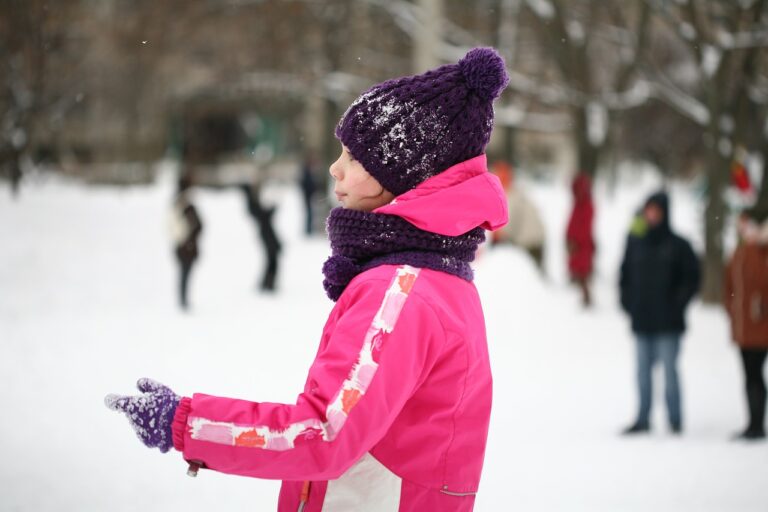
A happy kid inside is one who is comfortable wearing kids clothes for the outdoors. Making sure they’re dressed appropriately for the weather is one key to keeping them comfortable. But knowing how to dress your child for the outdoors, where the weather can quickly change from hot and sunny to cold and wet, isn’t always easy, especially when a child can’t tell you if they’re hot or cold. However, there are some guidelines and pointers that should help your child have a successful outdoor experience. (Also, snacks. Don’t forget to bring snacks.)
Choose Wool Fabrics or Synthetics
Kids clothes made of cotton can be appropriate for a casual outing on a pleasant, dry summer day. However, for active adventures or if the forecast calls for rain and/or cold temperatures, dressing your children in synthetic or wool clothing is the way to go. These fabrics wick moisture and dry quickly, so your child will be more comfortable if they work up a sweat or get wet from rain or snow. Here’s a quick rundown of common fabric options.
Wool:
Basic wool clothing can be itchy at times, but outdoor wool clothing is often made of soft, ultra-fine merino wool that is itch-free, breathable, moisture-wicking, fast-drying, and odor-resistant.
Cotton:
Cotton is soft against the skin but should be avoided for active outings. It takes a long time to dry and is a poor insulator, so getting wet from sweat or rain can leave you cold and shivering for hours.
Synthetics (polyester and nylon):
Synthetic clothing, such as polyester and nylon, is excellent at wicking moisture away from the skin. It is also usually less expensive than wool. Synthetics, on the other hand, tend to retain odors longer than wool.
Dress Your Children in Layers
Your children can benefit from the same outdoor strategy that you do: layering up to adapt to changing conditions. Simply put, if your child is cold, add layers and remove them when they warm up. Here are some examples of basic applications:
Put on a base layer.
This is the layer of underwear that wicks sweat away from the skin. In cold weather, this layer can be a wicking synthetic or wool long-underwear base layer that provides warmth while keeping skin dry. In warm weather, a base layer of synthetic or wool underwear and a T-shirt can suffice.
Put on a middle layer.
This layer protects against cold by retaining body heat. Fleece jackets and puffy insulated jackets are examples of middle-layer pieces. In general, thicker (or puffier) means warmer. The temperature of your middle layer is primarily determined by the weather you expect to encounter.
Put on an outer layer.
This is the layer that protects you from wind, rain, and snow. An outer shell is essential because wind and water can get into the middle and base layers, leaving your child severely chilled. A waterproof and breathable shell is essential for keeping an active child comfortable; non-breathable shells (such as rain ponchos and plastic slickers) can leave them wet from the inside out because sweat moisture cannot escape.
What your child should wear outside is determined by a variety of factors, including age, activity level, personal metabolism, outside temperature, wind speed, and others. The examples below are for a typical child who is old enough to walk down the trail on their own two feet. (A note about infants: Because babies do not move as much as older children and adults, they cannot generate as much heat. When dressing them for outdoor adventures, keep this in mind. In general, infants require one more layer than adults.)
Getting the Right Fit
To keep your kids hiking, running, climbing, jumping around, and having fun outdoors, it’s critical to get them clothes that fit properly. Ill-fitting kids clothes can be uncomfortable and even dangerous; you don’t want your children tripping over too-long pants. Understanding kids’ size charts is the first step in finding clothes that fit properly.
How do kids’ size charts work? Various clothing manufacturers handle sizing in slightly different ways, which can be very confusing. Here are some hints to help you interpret:
Sizes
Baby size is determined by age. Clothing for babies aged 0 to 24 months is typically available. Some include a range of ages, such as 3–6 months. If there isn’t a range, it’s safe to assume that the age listed is the maximum age that the piece is designed for and that it will likely fit children up to 3 months younger. However, because every baby is unique, buying clothes solely based on age can be misleading. When shopping, look for a brand-specific size chart that includes weight.
A T is included in the toddler size. A toddler size is indicated by a T next to the size number (e.g., 2T). Many brands offer three toddler sizes: 2T, 3T, and 4T. However, 5T does appear on occasion.
Kid size begins at size 4. Many parents are perplexed by the overlap of kid and toddler sizes. Should you purchase a 4 or 4T? It is necessary to consult a brand-specific size chart to understand the differences. 4 and 4T are interchangeable with some brands. Toddler sizing, on the other hand, has more room in the seat of the pants to accommodate a diaper. Others make size 4 for children taller than 4T.kids clote

Ways to be thrifty
Outdoor brands understand that you can’t afford to buy the most expensive technology, such as 900-fill-power down jackets or Gore-Tex® shells, for your child every season, so they help the cause by including quality, nonbranded technologies that perform admirably. Here are some additional budgeting suggestions:
Secondhand items from others. Everyone is fair game, including siblings, extended family, friends, and neighbors. Consider consignment shops or online resellers as well. Even a few dollars saved on a cap or a pair of mittens can help.
Other clothing that can be worn twice. Synthetic pajamas can be used as a base layer; thick wool socks can be cut up to make crude mitts for infants or toddlers; and old fleece outerwear can be cut up to make a neck gaiter.
Look for features that aid in the retention of gear. One example is glove leashes, which clip mittens or gloves to a jacket sleeve. In addition, built-in ID labels can save you a trip to the lost-and-found closet at school or daycare. (If a garment is missing, substitute your own.)
Choose Durable Products
Quality outdoor clothing for children frequently has built-in features that ensure you get a lot of use out of it. This includes features such as reinforced seats and knees, as well as high-quality fabrics that won’t tear easily. Buying durable products ensures that the equipment will not only keep up with the child for whom it was purchased, but it will also most likely last long enough to be passed down to a sibling, sold, or donated.
Purchase Easy-to-Put-On Clothes
Dressing a rambunctious child who can’t wait to get outside can be difficult. When shopping for children’s clothing, look for features that make it easier to put the items on. Elastic cuffs, waists, and hems keep you warm without requiring you to fiddle with waist cinches or cuff tabs. For infants and toddlers in diapers, consider how easy it is to access the diaper. Clothing with strategically placed snaps and/or zippers is beneficial.
Purchase Sun Protection Kids Clothes
Because children have thinner, more sensitive skin than adults, it is critical to consider their exposure to the sun’s ultraviolet rays whenever you are outside. Clothing is a very effective way to add protection, and buying clothes with an Ultraviolet Protection Factor (UPF) rating ensures that you are getting the protection you need.
Wearing UPF-rated clothing in conjunction with other methods, such as wearing sunglasses and a sun hat and applying sunscreen, can be effective.
Make a Growth Strategy
Quality clothing is built to last, so your children will outgrow them before they wear them out. Here are a few fit strategies to avoid buying a new set of winter outerwear every year:
Look for sleeves and cuffs that can be extended. A feature that allows you to add 1.5 to 2 inches to the arms or legs of a garment, which can buy you another season of use, has its own name. This is most noticeable in toddler and older children’s outerwear, particularly insulated pieces or snowsports items rather than windproof jackets, fleece, or down outerwear.
Purchase slightly larger items. A half- or full-size can be used for a middle or outer layer. Don’t get too carried away, though, because items that are far too large will not keep your child warm and will get in the way while he or she is running outdoors. Also, don’t buy base layers that are too big because they need to be in contact with your skin to wick sweat.
Look for Reflective Accents on Kids Clothes to Improve Visibility
Reflectivity becomes more important as the days shorten and darkness creeps into the morning and evening hours. With today’s technology, a small reflective logo or piping on a jacket can make it extremely visible when a pair of headlights sweep across it.
Toddlers do not need boots for hikes (sneakers will suffice), but bring extra socks to change into if there are puddles. However, older children can benefit greatly from a good pair of hiking shoes or boots. Consider how much a child can pound while tromping down the trail, chasing friends, and jumping off rocks. A good pair of hiking boots or shoes will provide them with the necessary support and traction. And they won’t just be shrunken adult shoes; they’ll be designed specifically for the anatomy of small feet. Find a pair of warm snow boots for your children to keep their toes warm in cold weather.
Search for Snow Features
Snow gaiters, reinforced cuffs, snow pass holders, and other features are available for your kids’ snow pants and jackets. Standard insulated outerwear should suffice for the occasional sled run or snowball fight.
Accessorize Your Extremities
Remember to pack essentials such as gloves, mittens, hats, and warm socks, especially on cold days.

